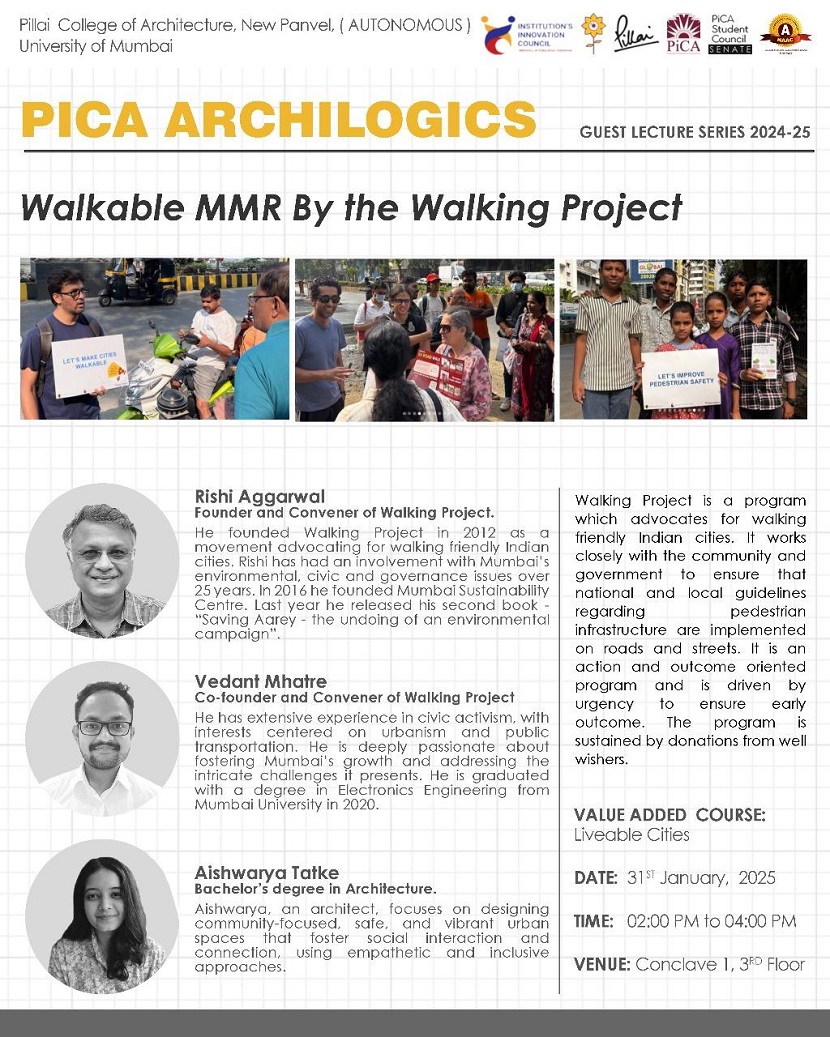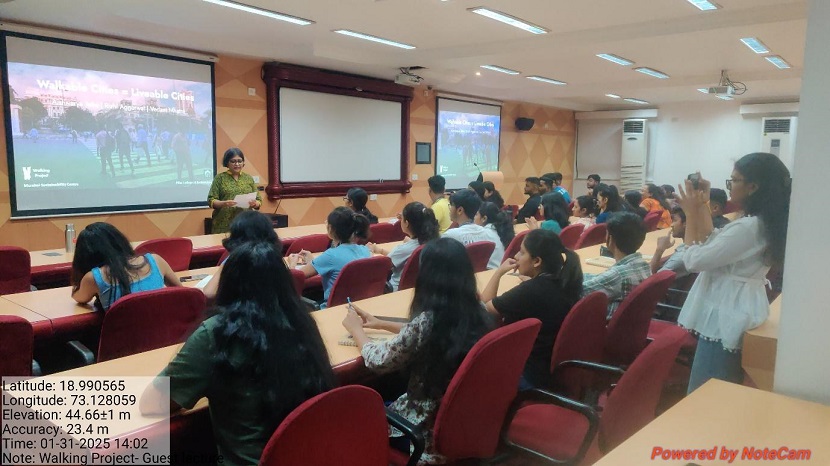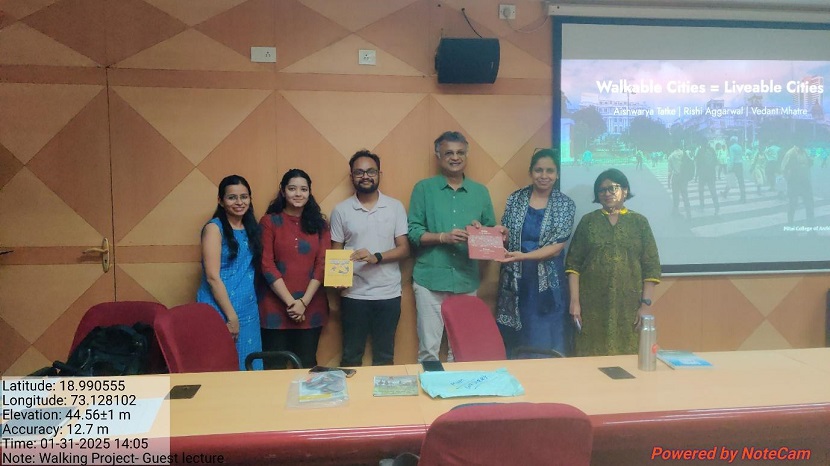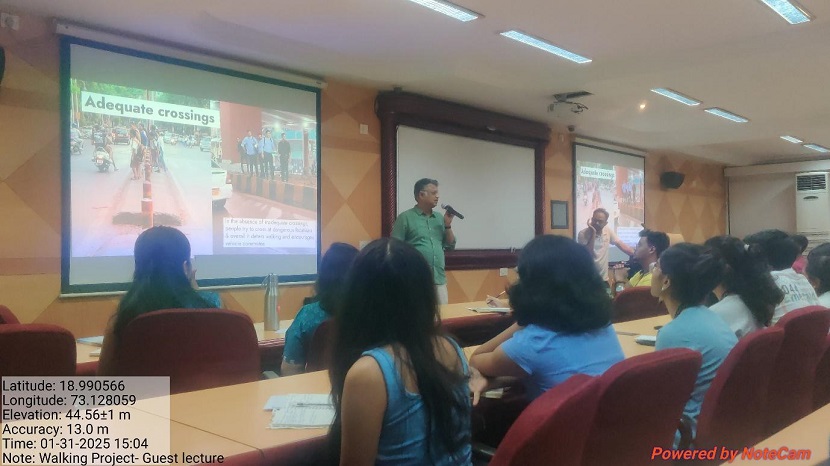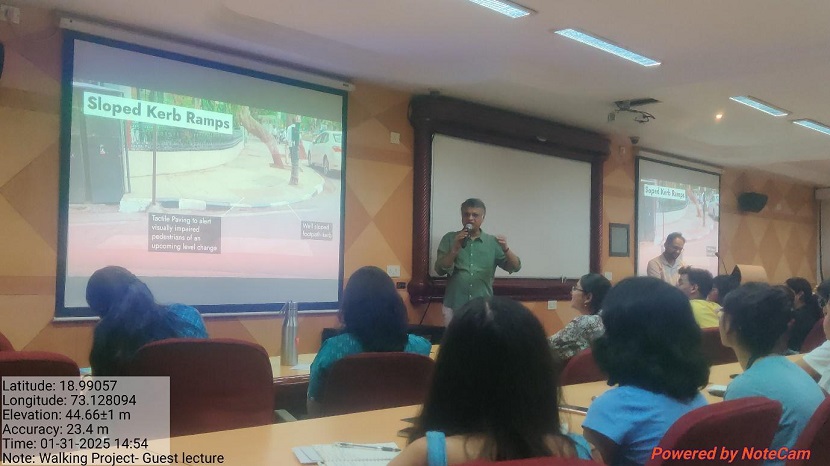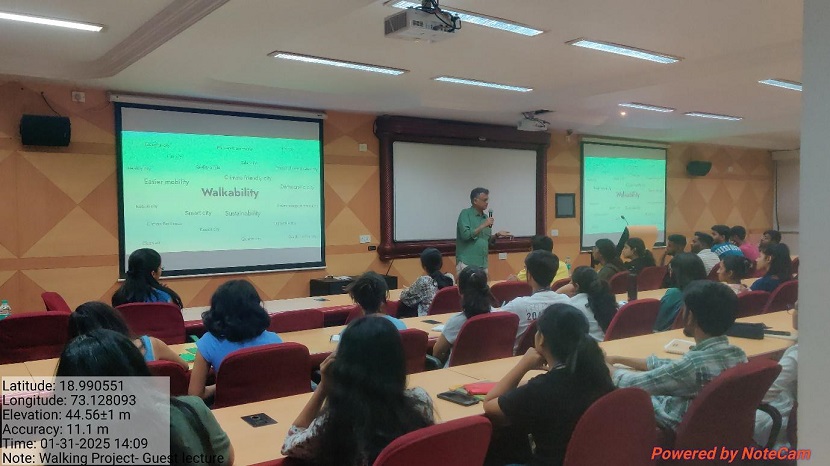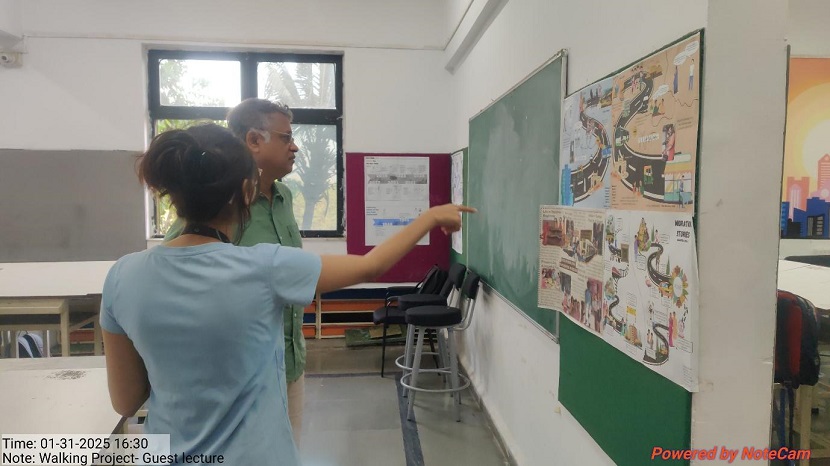| Subject | Value Added Course: Livable Cities (College Project and Humanities) |
| Session | 2024-25 |
| Year | 3rd |
| Date | 31st January 2025 |
| Time | 2:00 p.m. – 4:00 p.m. |
| Venue | Conclave 1 |
| Faculty Co-Ordinator | Prof. Smita Dalvi, Prof. Ajita Deodhar, Prof. Snehal Shirish Garg, Prof. Jagrati Sehgal |
| Guest Speaker | Rishi Aggarwal, Vedant Mhatre, Aishwarya Tatke |
| No. of Students | 30 |
| No. of Faculties | 11 |
Aim: The event “Walkable MMR by The Walking Project” aimed to explore various facets of walkability in urban spaces, emphasizing how thoughtful planning and infrastructure choices can improve pedestrian experiences by creating safer, more accessible, and engaging environments for walking.
Details of the event:
When and How the event was conducted
The event took place on 31st January 2025, Monday: 2:00 – 4:00 PM. It was very insightful and engaging lecture on “Walkable MMR by the Walking Project“, as a part of Value-Added Course on Livable Cities. The expertise and insightful presentation were truly engaging, and we’re deeply appreciative of the valuable knowledge and perspectives that were shared.
Significance of the event/topic
The lecture focused on how cities can design roads and infrastructure to be more pedestrian-friendly, ensuring accessibility and safety for people of all age groups. The Walking Project works towards transforming cities into walkable environments by advocating for better pedestrian infrastructure, such as wider sidewalks, safer crossings, and ensuring smooth surfaces without obstruction. The lecture emphasized how designing cities with pedestrians in mind can greatly improve the quality of life for all residents. In a rapidly urbanizing world, the insights shared in the lecture are crucial for creating cities that are not only easier to navigate but also healthier, more connected, and accessible for people of all ages.
Brief Introduction of the Guest
About Walking Project
Walking Project is a program which advocates for walking friendly Indian cities. It works closely with the community and government to ensure that national and local guidelines regarding pedestrian infrastructure are implemented on roads and streets. It is an action and outcome-oriented program and is driven by urgency to ensure early outcome. The program is sustained by donations from well-wishers.
Rishi Aggarwal
Rishi is the founder and convener of Walking Project. He founded Walking Project in 2012 as a movement advocating for walking friendly Indian cities. Rishi has had an involvement with Mumbai’s environmental, civic and governance issues over 25 years. During this period he has been involved with saving large urban greens like mangroves and Aarey, waste management and the cities transport policy and planning. In 2016 he founded Mumbai Sustainability Centre. Last year he released his second book – “Saving Aarey – the undoing of an environmental campaign”. Rishi graduated in economics in 1997 from Bombay University.
Vedant Mhatre
Vedant is the co-founder and convener of Walking Project. He has extensive experience in civic activism, with interests centered on urbanism and public transportation. He is deeply passionate about fostering Mumbai’s growth and addressing the intricate challenges it presents. Over the years, he has effectively utilized media and digital platforms to advance his activism in both personal and professional capacities. Vedant graduated with a degree in Electronics Engineering from Mumbai University in 2020.
Aishwarya Tatke
Aishwarya is an architect interested in the interaction of people with the built and unbuilt spaces in the environment. She is keen on analysing the design of urban spaces that shape our daily experiences; influencing how we navigate, interact, and connect with our environment. Through her career, she has worked towards creating community-focused spaces that are safe and vibrant, through placemaking and participatory processes. She believes in an empathetic and inclusive approach to design. Aishwarya graduated in 2022 with a Bachelor’s degree in Architecture.
Gist / points covered in lecture / Event
The lecture explored various key aspects of walkability, offering a detailed look at how thoughtful design choices can enhance the experience of walking through urban areas. It emphasized the importance of considering multiple factors to ensure safe, accessible, and comfortable pedestrian pathways. Key points discussed included:
- Footpath Width: Ensuring enough space for pedestrians, especially in busy areas.
- Footpath Height: Maintaining an even and appropriate height for smooth walking.
- Surface Quality: Using durable, non-slip materials to improve safety and comfort.
- Kerb Ramps: Providing smooth transitions for wheelchair users, strollers, and cyclists.
- Continuous Walking Length: Designing uninterrupted paths for easier movement.
- Raised Tree Grating: Installing tree grates that don’t obstruct walkways but still allow tree growth.
- Obstructions: Minimizing barriers such as building entrances or utility poles that block pathways.
- Signal Timer Height: Ensuring that traffic signal timers are easily visible to pedestrians.
- Intersection Sesign: Creating safer crossings with proper signage and lighting at intersections.
- Traffic Islands: Designing safe spaces for pedestrians to wait when crossing busy roads.
- Adequate Crossings: Providing well-placed, safe pedestrian crossings to connect different areas of the city.
- Hawkers: Managing street vendors to ensure they don’t obstruct pedestrian movement.
- Parking on the Road: Addressing the issue of cars parked on sidewalks, which can impede pedestrian flow.
The lecture broadly covered two aspects:
-
What makes a walk walkable? The lecture explained that a walkable environment goes beyond just having sidewalks; it involves creating spaces that are safe, comfortable, and engaging for pedestrians. All the factors explained above are covered in detail, and the importance of each was discussed. A walkable city also considers the connection between different parts of the city, making it easy and enjoyable for people to move from one place to another on foot.
-
What does The Walking Project do? The Walking Project is an initiative focused on making cities (Mumbai Metropolitan region) more pedestrian-friendly by advocating for better infrastructure and urban planning. Their work involves raising awareness about the importance of walkability, conducting studies to identify key areas for improvement, and collaborating with city planners and policymakers to implement changes. They aim to create urban environments that prioritize pedestrians, enhance safety, and encourage walking as a primary mode of transportation, benefiting people of all ages and abilities.
Brief take away of the event/lecture
The key takeaway from the lecture is the importance of thoughtful urban design in creating walkable cities. By focusing on factors like footpath width, surface quality, safe crossings, and the removal of obstructions, cities can significantly improve the pedestrian experience. The lecture also emphasized that a truly walkable city is one that is not only safe and accessible but also engaging, with amenities and connections that encourage walking. Furthermore, The Walking Project’s efforts highlight how advocacy, research, and collaboration can drive real change in urban planning, ultimately making cities more pedestrian-friendly for people of all ages and abilities. The overall message is clear: prioritizing walkability leads to healthier, more sustainable, and livable urban spaces.
The session proved to be incredibly insightful, offering valuable perspectives and thought-provoking ideas. It was a great opportunity to gain new knowledge and explore different viewpoints. Following the session, the audience engaged in healthy discussions that further enriched the experience. These discussions provided a wide range of inputs, allowing to dive deeper into the subject matter and consider various angles. The exchange of ideas was constructive and collaborative, helping to clarify points and spark new lines of thinking. Overall, it was an enriching experience that left me with a broader and more nuanced understanding.
